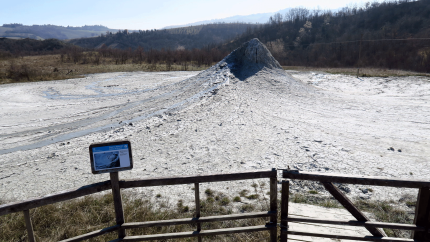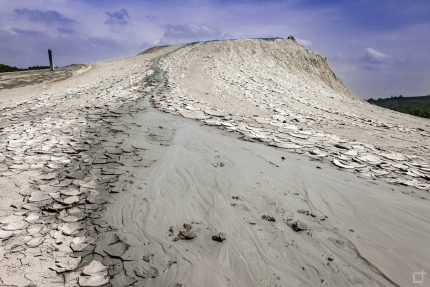Nirano’s Mud-Volcanoes Nature Reserve
Country: Italy.
Established in: 1982.
Surface area: 209 hectares.
Municipalities: Fiorano Modenese (MO).
Main features: Natural “Mud Volcanoes” geological singularity, halophilic vegetation.
Discover the Park!
Park Description
The Nirano´s Mud Vulcanoes Nature Reserve - Salse di Nirano in Italian - was the first regional reserve to be established in Emilia-Romagna (1982) and is entirely within the municipal territory of Fiorano Modenese, not far from Maranello, in the province of Modena. It protects the largest and most peculiar complex of Salse in the region and, with that of Aragon (Agrigento - Sicily), the most important in Italy and one of the most complexes in Europe.
The reserve consists of a small hilly basin, between the altitudes of 150 and 300 meters above sea level, mainly characterized by “Badlands landscape”, at the center of which are the most significant pseudo-volcanic events. It is divided into an area (5 ha) of Integral Protection Zone A), including the unique and well-preserved geological manifestations of mud volcanoes, and other 200 ha of areas at a lower level of protection. Only a part of the reserve is on public land (26 hectares), while almost 90% of the remaining land is private but subject to environmental protection constraints, while the site of Community interest (SCI) of Salse di Nirano extends for 371 hectares.

Mud Vulcano and information sign - Photo by Emila-Romagna Region
The volcanoes are generated by the continuous rise of cold and salty mud (hence the name "Sauces"), mixed with hydrocarbons mainly gaseous (90% composed of methane) and marginally liquid (oil), which, after forming in hydrocarbon deposits located at a shallow depth (about 1000m), come to the surface through faults and fractures of the ground, dissolving and fluidizing the traversed Pliocene grey-azure clays and thus giving rise to the typical formation of cone or chickens The unique geological phenomenon, although not the unique of this kind in Italy, is undoubtedly the most impressive. It has interested researchers since ancient times, as evidenced by several archaeological finds in the area, and studied by famous scientists of the past, with very imaginative observations on the so-called "mud volcanoes" and still attracts scholars and simple onlookers from all over Europe, also thanks to the proximity of Maranello and the factory of Ferrari cars, but in a very quiet environment.
Walking through the Salse di Nirano, in fact, you can clearly perceive the mumbling of the mud that bubbles in the puddles from which it gushes, mixed with the only noise of nature that moves under the wind and the song of birds and frogs that inhabit these lands Today the area is also a Geosite of international importance, whose geological significance also helps to explain the formation and the current state of evolution of the Apennine chain. In addition to the formation, the morphological evolution of these apparatuses is very particular, since they have to undergo a balance of growth due to new eruptions and decay due to rainwater that leads to the melting of the mud. This dynamic is studied and monitored over time by the University of Modena and Reggio Emilia and will see a further improvement by the CEETO Project tourists monitoring activities.

Mud flow in one of the Vulcanoes - Photo by Emilia-Romagna Region
The Reserve area includes the Visitor Centre Cà Tassi, on the southern side of the reserve, and the Eco-Museum Cà Rossa, on the northern side of the reserve. The Cà Tassi Visitor Centre is housed in an old rural complex, which has been renovated according to the latest criteria of green building and energy saving. It has information material and a small shop where you can buy material related to the visit and is also home to the FootHill CEAS - Centre for Education to Sustainability. Inside there is also a natural and ornithological exposure as well as minerals and fossils. In the Cà Rossa eco-museum, inaugurated in 2010 inside a nineteenth century building of historical and architectural value, we remember the traditions and tools used in this land in past decades, through photographs, panels, documents and agricultural tools on display. In the museum there are also 8 panels that describe the peculiarities of the Salse di Nirano, guiding the visitor on a virtual tour of what is actually staged a few meters out of the museum.
The Nirano´s Mud Vulcanoes Natural Reserve is part of the Central Emilia Parks Managing Authority and is one of the main stages of the Via dei Vulcani di Fango path, an emotional route of over 60 km that crosses six municipalities, touching more than 50 points of interest including historical houses, archaeological sites and environmental heritages.

Visitors at the Mud Vulcanoes - Photo by Emilia-Romagna Region
Thanks to the visitor centers, the network of 13 equipped paths and educational paths open to all visitors, even to the disabled and visually impaired thanks to wooden walkways arranged ad hoc in the area where the presence of vulcanoes is higher, and the closeness to the Apennine front and to the most urbanized villages, the Reserve is visited by about 70’000 visitors per year.
To visit the Nature Reserve there are two free apps that offer maps and guides and complete information about the area: the app Via dei Vulcani di Fango and the app Sentieri dell'Appennino.
CEETO Pilot Action Objective
The Pilot Action aims to implement a monitoring data-based and participating-based tourism governance model in the Nirano´s Muid Vulcanoes Nature Reserve, characterized by its very interesting but also fragile geological and environmental features and by a significant touristic flow, also in the area of the highest protection level.
